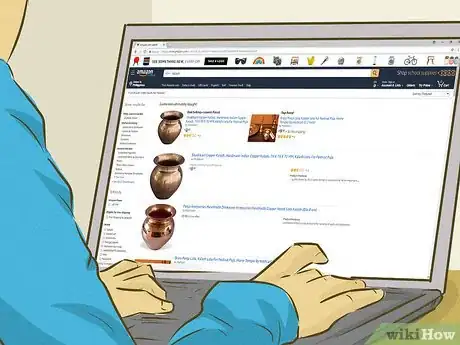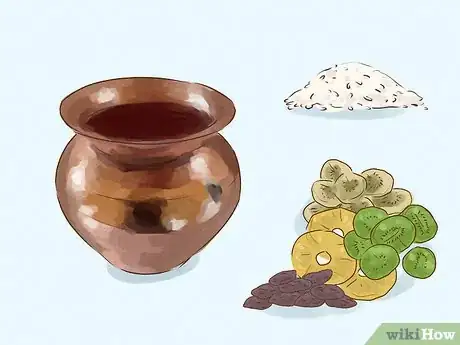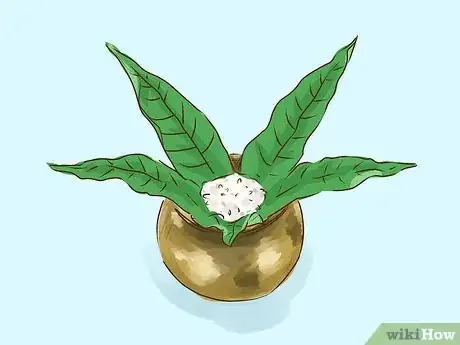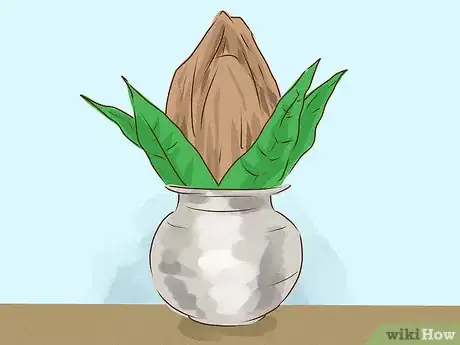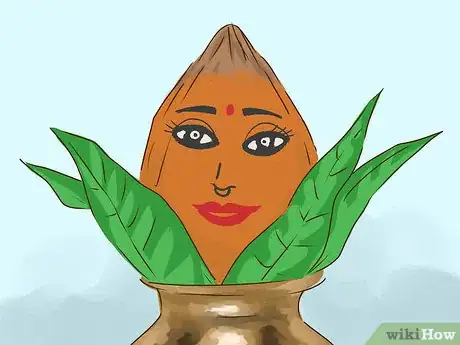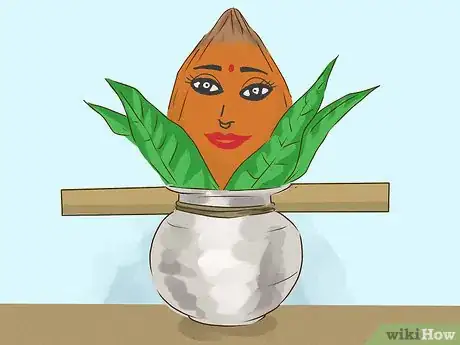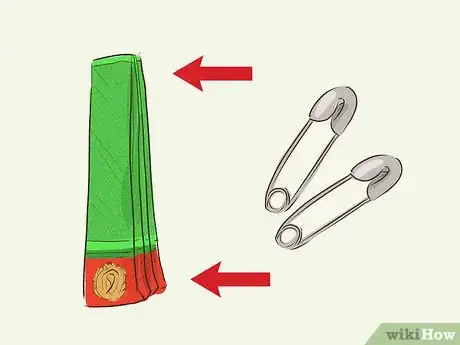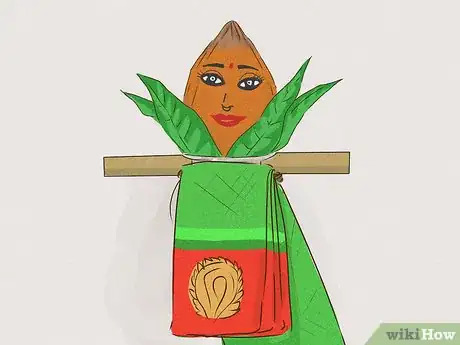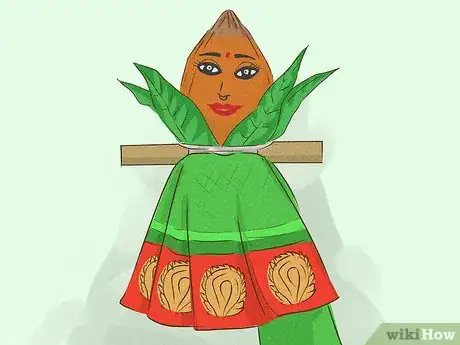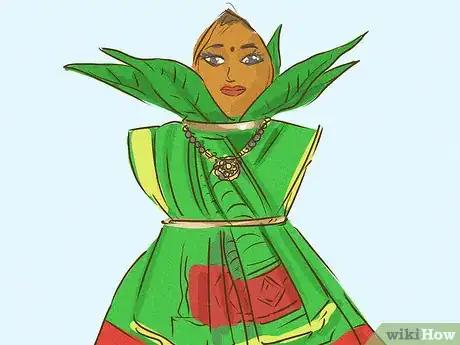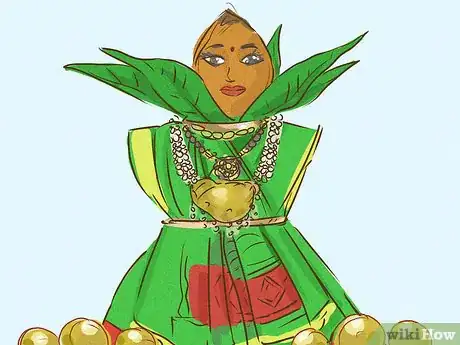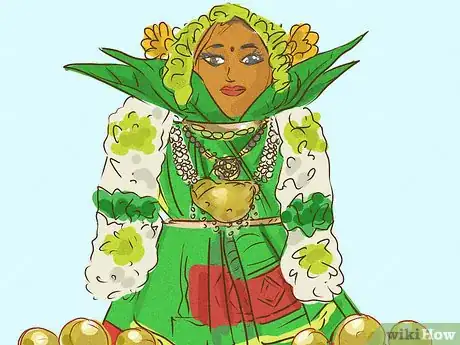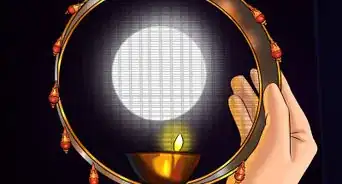This article was co-authored by wikiHow Staff. Our trained team of editors and researchers validate articles for accuracy and comprehensiveness. wikiHow's Content Management Team carefully monitors the work from our editorial staff to ensure that each article is backed by trusted research and meets our high quality standards.
There are 12 references cited in this article, which can be found at the bottom of the page.
This article has been viewed 29,158 times.
Learn more...
Every year, many Indian women celebrate Varalakshmi in honor of the goddess of wealth and prosperity, Lakshmi. The festival takes place on the Friday before the full moon in the Hindu month of Shravana. To prepare, women often decorate a kalash (a metal pot) to resemble Varalakshmi herself and adorn her with vibrant colors, jewels, and bright fabrics.
Steps
Preparing the Kalash
-
1Buy a gold, silver, or copper kalash online or from an Indian store. A kalash is a metal pot that has a large base and a slightly smaller mouth that is big enough to hold a coconut. The kalash may be smooth in texture or have intricate designs carved into it.
- You can find a kalash at a specialty store, a home store, or on Amazon.
- A kalash looks similar to a pitcher or urn. If you don't have a kalash, you can substitute one of these in a pinch.
-
2Fill the kalash with water and offerings like raw rice and dried fruit. Other common items put inside the kalash are betel nuts, betel leaves, coins, and dates. You can also include bangles, combs, or any other feminine things that the goddess would appreciate.[1]
- The rice symbolizes prosperity and good fortune.
- It is believed that the goddess Lakshmi lives in the lower tip of a betel leaf. Betel leaves and nuts are also considered foods of the gods.[2]
Advertisement -
3Lay 5 mango leaves across the top of the kalash. Fan them out, covering the mouth completely. Make sure the tips of the mango leaves are facing up towards the ceiling.[3]
- Mango leaves are thought to be the god’s seat, as well as prevent negative energy.[4]
- The 5 leaves also represent the 5 senses (smell, touch, taste, sound, and sight).
- You can buy mango leaves in bulk online.
-
4Place a coconut on top of the mango leaves. Sit it so that the "tail" of the coconut (the side with the 3 holes on it) is pointing up. The coconut should rest snugly inside the mouth with the leaves fanning out around it.
-
5Draw Lakshmi’s face with turmeric paste on the coconut. Turmeric (also known as haldi) is viewed as holy by Indians. A symbol of prosperity and marriage, it is often offered when you're praying for the lives of spouses or family.[7]
- You can also smear the turmeric paste all over the kalasam.
- If you don’t want to draw the face, you can attach an image of Lakshmi to the coconut using a thread. You can even use a piece of silver or a coin with Lakshmi's image pressed into it.[8]
Draping a Saree on Varalakshmi
-
1Attach a sturdy stick to the mouth of the kalasam with wire and tape. Place it at the back of the kalasam. The stick should be longer than the kalasam is wide so that the ends of the stick extend outwards.
- For example, if your kalasam is 4 inches (10 cm) wide, use a stick that’s about 10 inches (25 cm) long.[9]
-
2Make pleats along the length of a saree, leaving enough for the pallu. To pleat the fabric, fold the saree once, then fold it back over itself. Repeat this in equal-sized sections until you’ve pleated the whole saree except for the amount you choose to keep unpleated for the pallu.[10]
- Choose a red or green silk saree. Since Lakshmi represents married women, she should wear a saree in red or green hues which are the most common wedding colors.[11]
- While any fabric can be used, a soft silk is the easiest to drape.
-
3Pin the pleats on both ends of the saree with a safety pin. Secure both the top and the bottom of the saree, keeping the pleats folded tightly together. This can be difficult to do with just 2 hands, so you may want to ask a friend to hold the pleats while you pin them.
- The trick to pinning pleats is to place the safety pin vertically in line with the pleats, instead of horizontally across them. This prevents the pleats from shifting.
-
4Fold the saree so that one end is slightly longer than the other and tie it. Use a piece of thread to tightly secure the fold. Make sure that you don’t fold the saree perfectly in half. You’ll need one side to be longer when you go to drape the saree on the kalash.[12]
- Be careful to keep the saree taut as you fold so that the pleats don’t fall out.
- Pull the thread as tightly as possible when you’re tying it so it doesn’t slide down the saree. A double knot will help prevent the thread from coming undone later on.
-
5Secure the tied part of the saree to the kalasam’s mouth with thread. Wrap another piece of thread around the kalasam right at its opening and tie that thread onto the thread that’s currently keeping your saree together.[13]
- The longer end of the folded saree should be on the bottom.
-
6Remove the pins and spread out the pleats around the kalasam. Gently pull the pleats of the longer end to completely cover the base of the kalasam. The shorter pleats should fall over top of the longer ones, creating a second layer.[14]
- You can pin the saree pleats behind the kalash, hidden from sight. This will help keep the kalash covered and the pleats in place.
-
7Pleat the pallu and take it over the left stick, then back over the right. Think of the sticks as shoulders as you’re draping.[15] Keep the pallu pleated as you do this. When the pallu is once again in front of the kalasam, let it hang neatly down the right side.[16]
- You can pin the pleats in the pallu if you’re having trouble holding them together.
- Make sure the sticks are completely hidden underneath the pallu.
- One variation is to pull the pallu across the front of the kalasam and pin it on the left side.
-
8Secure the pallu at the base of the kalasam with thread. This will create a “waist” for the saree. If you don’t like the look of the exposed thread, cover it with a necklace or another piece of jewelry.[17]
Adding Accessories
-
1Tie the mangal sutra necklace around her neck. In Hindu culture, the mangal sutra is a sacred strand of black beads on a gold cord. It is tied around a bride’s neck in 3 knots when she is married.
- It symbolizes the union between a man and wife, just like that of Lakshmi and her husband, Vishnu.[18]
-
2Adorn the idol with gold jewelry. Jewelry holds a lot of significance in Indian culture. Clasp gold necklaces to the kalasam or scatter other baubles at the base of Varalakshmi.
- Women who are decked out in blinged-out bracelets, necklaces, and earrings are viewed as wealthier and more prosperous.
- Gold in particular is a sign of status in India and often given as gifts at weddings.[19]
-
3Drape flower garlands around the kalasam as a sign of adoration. Not only are garlands common offerings given to the gods and goddesses, they are also given as gifts at marriage which Varalakshmi celebrates.[20]
- Choose flowers with pretty scents like jasmine, roses, or lilies.
- Lakshmi herself is often portrayed on a lotus throne so a strand of lotuses is an appropriate accessory.
References
- ↑ http://www.beliefnet.com/faiths/hinduism/2006/08/ritual-initiation.aspx
- ↑ https://www.indiadivine.org/significance-thamboolam-betel-leaf/
- ↑ http://www.indusladies.com/culture/top-20-questionsdoubts-on-varalakshmi-pooja/
- ↑ https://www.hindujagruti.org/hinduism/knowledge/article/why-are-mango-leaves-kept-in-the-kalash-during-puja-ritual.html
- ↑ https://www.boldsky.com/yoga-spirituality/faith-mysticism/2014/ten-things-to-attract-goddess-lakshmi-042944.html
- ↑ http://www.indusladies.com/culture/top-20-questionsdoubts-on-varalakshmi-pooja/
- ↑ https://medium.com/@MyTemple/8-essential-facts-about-kumkum-6a555a233caa
- ↑ https://www.hinduismtoday.com/modules/smartsection/item.php?itemid=5077
- ↑ http://saree.guide/how-to-wear-saree-for-varamahalakshmi-pooja/
- ↑ http://saree.guide/how-to-wear-saree-for-varamahalakshmi-pooja/
- ↑ https://www.boldsky.com/yoga-spirituality/faith-mysticism/2016/sarees-to-drape-for-goddess-lakshmi-on-kalasha-104362.html
- ↑ http://saree.guide/how-to-wear-saree-for-varamahalakshmi-pooja/
- ↑ http://saree.guide/how-to-wear-saree-for-varamahalakshmi-pooja/
- ↑ http://saree.guide/how-to-wear-saree-for-varamahalakshmi-pooja/
- ↑ http://saree.guide/how-to-wear-saree-for-varamahalakshmi-pooja/
- ↑ http://saree.guide/how-to-wear-saree-for-varamahalakshmi-pooja/
- ↑ http://saree.guide/how-to-wear-saree-for-varamahalakshmi-pooja/
- ↑ https://www.culturalindia.net/weddings/wedding-traditions/mangalsutra.html
- ↑ https://www.bankbazaar.com/gold-rate/significance-of-gold-in-indian-culture.html
- ↑ https://garlandmag.com/article/mala-the-floral-garlands-of-india/
